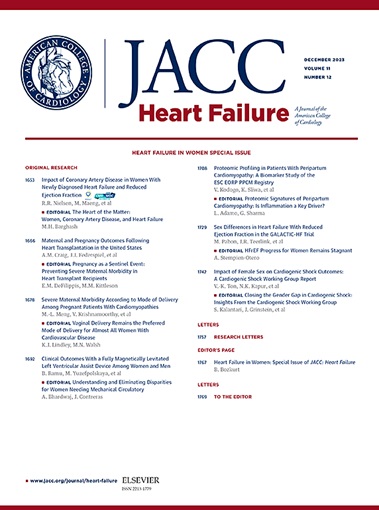Prevalence and Associations of Systemic Inflammation in Heart Failure Across the Spectrum of Ejection Fraction.
IF 11.8
1区 医学
Q1 CARDIAC & CARDIOVASCULAR SYSTEMS
引用次数: 0
Abstract
BACKGROUND Systemic inflammation contributes to the pathophysiology of heart failure (HF). Inflammation in heart failure with mildly reduced ejection fraction (HFmrEF) or heart failure with preserved ejection fraction (HFpEF) has been linked to cardiovascular-kidney-metabolic conditions, whereas inflammation in heart failure and reduced ejection fraction (HFrEF) is thought to develop secondary to cardiac stress and circulatory derangements. OBJECTIVES This study aims to characterize the prevalence and correlates of systemic inflammation across the spectrum of HF. METHODS Patients with HF participating in 3 large outcome trials (SELECT, SOUL, and FLOW) were examined to identify the prevalence of systemic inflammation, defined as elevated high-sensitivity C-reactive protein (hsCRP) ≥2 mg/L. Clinical characteristics associated with elevated hsCRP were examined by HF subtype and across the HF spectrum. RESULTS Across the 3 trials, 3,204 patients had HFpEF, 1,246 had HFmrEF, and 1,018 had HFrEF. Elevated hsCRP was observed in 2,335 patients (52.5%) with HFpEF/HFmrEF and 503 patients (49.4%) with HFrEF. Compared with patients with lower hsCRP levels, those with higher hsCRP levels were more likely to be female and have obesity, diabetes, lower estimated glomerular filtration rate, higher albuminuria, and chronic obstructive pulmonary disease, without meaningful differences by HF subtype. hsCRP level was unrelated to ejection fraction (R2 < 0.001; P = 0.73) but increased linearly with the number of comorbidities for all HF subtypes (R2 = 0.94; P < 0.001). CONCLUSIONS Systemic inflammation is present in one-half of patients with HF, and is associated with excess body fat, chronic kidney disease, albuminuria, and diabetes, and increases with comorbidity burden. These relationships are not specific to HFpEF/HFmrEF but are also common to HFrEF (Semaglutide Effects on Heart Disease and Stroke in Patients With Overweight or Obesity [SELECT]; NCT03574597; A Research Study to See How Semaglutide Works Compared to Placebo in People With Type 2 Diabetes and Chronic Kidney Disease [FLOW]; NCT03819153; A Heart Disease Study of Semaglutide in Patients With Type 2 Diabetes [SOUL]; NCT03914326).射血分数范围内心力衰竭全身性炎症的患病率和相关性。
背景:全身性炎症有助于心衰(HF)的病理生理。心力衰竭伴轻度射血分数降低(HFmrEF)或心力衰竭伴保留射血分数(HFpEF)的炎症与心血管-肾脏-代谢状况有关,而心力衰竭伴射血分数降低(HFrEF)的炎症被认为是继发于心脏应激和循环紊乱。目的:本研究旨在描述HF全身性炎症的患病率及其相关因素。方法参与3个大型结局试验(SELECT、SOUL和FLOW)的HF患者进行检查,以确定全身性炎症的患病率,定义为高敏感性c反应蛋白(hsCRP)升高≥2mg /L。与hsCRP升高相关的临床特征通过HF亚型和整个HF谱进行了检查。结果在这3项试验中,3204例患者患有HFpEF, 1246例患有HFmrEF, 1018例患有HFrEF。在2335例HFpEF/HFmrEF患者(52.5%)和503例HFrEF患者(49.4%)中观察到hsCRP升高。与hsCRP水平较低的患者相比,hsCRP水平较高的患者更有可能是女性,并且有肥胖、糖尿病、肾小球滤过率较低、蛋白尿较高和慢性阻塞性肺疾病,而HF亚型之间没有显著差异。hsCRP水平与射血分数无关(R2 < 0.001; P = 0.73),但与所有HF亚型共病数量呈线性增加(R2 = 0.94; P < 0.001)。结论:半数心衰患者存在全身性炎症,与体脂过多、慢性肾病、蛋白尿和糖尿病相关,并伴有合并症负担增加。这些关系不是HFpEF/HFmrEF所特有的,但在HFrEF中也很常见(Semaglutide对超重或肥胖患者心脏病和卒中的影响[SELECT]; NCT03574597;一项研究研究Semaglutide与安慰剂相比在2型糖尿病和慢性肾脏疾病患者中的作用[FLOW]; NCT03819153; Semaglutide在2型糖尿病患者中的心脏病研究[SOUL]; NCT03914326)。
本文章由计算机程序翻译,如有差异,请以英文原文为准。
求助全文
约1分钟内获得全文
求助全文
来源期刊

JACC. Heart failure
CARDIAC & CARDIOVASCULAR SYSTEMS-
CiteScore
21.20
自引率
2.30%
发文量
164
期刊介绍:
JACC: Heart Failure publishes crucial findings on the pathophysiology, diagnosis, treatment, and care of heart failure patients. The goal is to enhance understanding through timely scientific communication on disease, clinical trials, outcomes, and therapeutic advances. The Journal fosters interdisciplinary connections with neuroscience, pulmonary medicine, nephrology, electrophysiology, and surgery related to heart failure. It also covers articles on pharmacogenetics, biomarkers, and metabolomics.
 求助内容:
求助内容: 应助结果提醒方式:
应助结果提醒方式:


